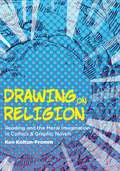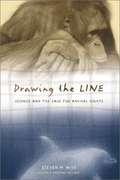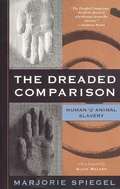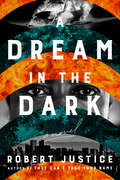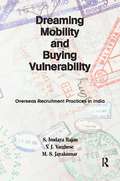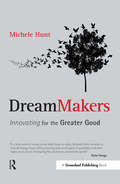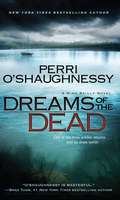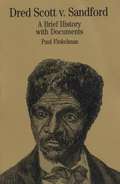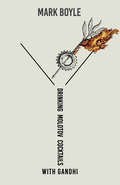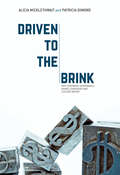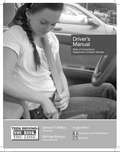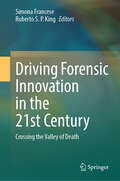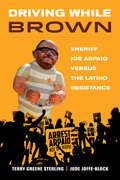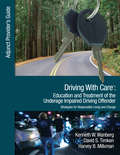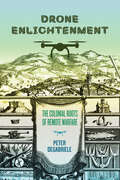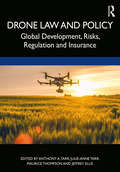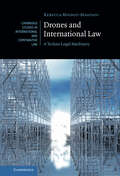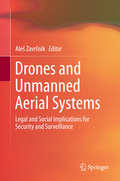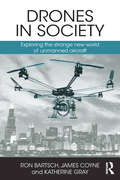- Table View
- List View
Drawing on Religion: Reading and the Moral Imagination in Comics and Graphic Novels
by Ken Koltun-FrommComics traffic in stereotypes, which can translate into real danger, as was the case when, in 2015, two Muslim gunmen opened fire at the offices of Charlie Hebdo, which had published depictions of Islam and Muhammad perceived by many to be blasphemous. As a response to that tragedy, Ken Koltun-Fromm calls for us to expand our moral imaginations through readings of graphic religious narratives.Utilizing a range of comic books and graphic novels, including R. Crumb’s Book of Genesis Illustrated, Craig Thompson’s Blankets, the Vakil brothers’ 40 Sufi Comics, and Ms. Marvel, Koltun-Fromm argues that representing religion in these formats is an ethical issue. By focusing on the representation of Christian, Jewish, Muslim, and Hindu religious traditions, the comics discussed in this book bear witness to the ethical imagination, the possibilities of traversing religious landscapes, and the problematic status of racial, classed, and gendered characterizations of religious persons. Koltun-Fromm explores what religious stereotypes do and how they function in comics in ways that might expand or diminish our imaginative worlds. The pedagogical challenge, he argues, is to linger in that space and see those worlds well, with both ethical sensitivity and moral imagination.Accessibly written and vibrantly illustrated, this book sheds new light on the ways in which comic arts depict religious faith and culture. It will appeal to students and scholars of religion, literature, and comic studies.
Drawing on Religion: Reading and the Moral Imagination in Comics and Graphic Novels
by Ken Koltun-FrommComics traffic in stereotypes, which can translate into real danger, as was the case when, in 2015, two Muslim gunmen opened fire at the offices of Charlie Hebdo, which had published depictions of Islam and Muhammad perceived by many to be blasphemous. As a response to that tragedy, Ken Koltun-Fromm calls for us to expand our moral imaginations through readings of graphic religious narratives.Utilizing a range of comic books and graphic novels, including R. Crumb’s Book of Genesis Illustrated, Craig Thompson’s Blankets, the Vakil brothers’ 40 Sufi Comics, and Ms. Marvel, Koltun-Fromm argues that representing religion in these formats is an ethical issue. By focusing on the representation of Christian, Jewish, Muslim, and Hindu religious traditions, the comics discussed in this book bear witness to the ethical imagination, the possibilities of traversing religious landscapes, and the problematic status of racial, classed, and gendered characterizations of religious persons. Koltun-Fromm explores what religious stereotypes do and how they function in comics in ways that might expand or diminish our imaginative worlds. The pedagogical challenge, he argues, is to linger in that space and see those worlds well, with both ethical sensitivity and moral imagination.Accessibly written and vibrantly illustrated, this book sheds new light on the ways in which comic arts depict religious faith and culture. It will appeal to students and scholars of religion, literature, and comic studies.
Drawing Out Law
by John BorrowsThe Anishinabek Nation's legal traditions are deeply embedded in many aspects of customary life. In Drawing Out Law, John Borrows (Kegedonce) skillfully juxtaposes Canadian legal policy and practice with the more broadly defined Anishinabek perception of law as it applies to community life, nature, and individuals.This innovative work combines fictional and non-fictional elements in a series of connected short stories that symbolize different ways of Anishinabek engagement with the world. Drawing on oral traditions, pictographic scrolls, dreams, common law case analysis, and philosophical reflection, Borrows' narrative explores issues of pressing importance to the future of indigenous law and offers readers new ways to think about the direction of Canadian law.Shedding light on Canadian law and policy as they relate to Indigenous peoples, Drawing Out Law illustrates past and present moral agency of Indigenous peoples and their approaches to the law and calls for the renewal of ancient Ojibway teaching in contemporary circumstances.This is a major work by one of Canada's leading legal scholars, and an essential companion to Canada's Indigenous Constitution.
Drawing the Line: Science and the Case for Animal Rights
by Steven M. WiseAre we ready for parrots and dolphins to be treated as persons before the law? In this unprecedented exploration of animal cognition along the evolutionary spectrum--from infants and children to other intelligent primates, from dolphins, parrots, elephants, and dogs to colonies of honeybees--Steve Wise finds answers to the big question in animal rights today: Where do we draw the line? Readers will be enthralled as they follow Wise's firsthand account of the world's most famous animal experts at work: Cynthia Moss and the touchingly affectionate families of Amboseli; Irene Pepperberg and her amazing and witty African Grey parrot, Alex; and Penny Paterson with the formidable gorilla Koko. In many cases, Wise was able to sustain an extended conversation with these extraordinary creatures. No one with even a shred of curiosity about animal intelligence or justice will want to miss this book.
The Dreaded Comparison: Human And Animal Slavery
by Marjorie Spiegel Alice WalkerConsidered a seminal book in the fields of Bioethics and Human-Animal Studies, and a classic in the field of humane thought, Marjorie Spiegel's The Dreaded Comparison makes a significant contribution to our efforts to understand the roots of individual and societal violence, tying current cultural practices to the legacy of human bondage, and introducing new and diverse audiences to the history of slavery and institutionalized racism in the United States. Spanning history, psychology, and current events-- and ground-breaking for its thesis which presents the first in-depth exploration of the similarities between the violence humans have wrought against other humans, and our culture's treatment of non-human animals-- The Dreaded Comparison has contributed to subsequent explorations by other scholars, historians, legal scholars, law professors and educators in diverse fields to view and further define the modern system of animal exploitation in terms of the model and legacy of human slavery. The Dreaded Comparison also contributed substantially to broadening the philosophical foundation of the modern discourse about animals beyond its traditionally more limited scope, instilling a far more inclusive and historically-grounded understanding of the critical issues Spiegel sensitively explores in this book.
A Dream in the Dark (A Wrongful Conviction Novel #2)
by Robert JusticeWith striking prose and inspired by real wrongful conviction cases, this layered takedown of the criminal justice system follows one woman&’s quest for answers as the fate of an innocent man hangs in the balance, perfect for fans of S. A. Cosby.Denver, 1992. Claudette Cooper and Moses King have been failed by the justice system. Claudette was sexually assaulted and brutally attacked—blinded by the perpetrator, she&’s not able to identify him until she has a dream about the attack where she sees the face of Moses King. When Claudette testifies that she&’s identified her attacker from her dream, Moses is wrongfully convicted and sent to prison for the crime.Lawyer Liza Brown has seen firsthand the failings and shortcomings of the justice system—her father also suffered the injustice of a wrongful conviction. As she&’s working at a nonprofit to free those who have been wrongfully imprisoned, Moses reaches out to her. Liza sees the obvious cracks in the evidence against Moses, and when he confesses that he knew her father, she&’s determined to help. Recruiting her old friend Eli Stone to assist, Liza sets out to prove Moses&’s innocence. But Eli is dealing with demons of his own: corrupt cops are targeting Black residents of Denver, and when his nephew is beaten by the police, Eli doubles down on his efforts to expose them.Frustrated, Liza turns to Moses&’s accuser, Claudette, for help. But Claudette is hiding a dark secret, and as tensions in Denver rise, the city erupts in protests and riots. This rich, impactful novel paints a portrait not only of injustice and desperation—but of hope.
Dreaming Mobility and Buying Vulnerability: Overseas Recruitment Practices in India
by S. Irudaya Rajan V. J. Varghese M. S. JayakumarIn the alarming contemporary context of widespread corruption and fraudulence in the overseas labour recruitment system in India, this book attempts to understand the institution of emigration governance and recruitment practices in the country with a focus on the unskilled and semi-skilled sectors. It brings together the results of research in the major emigration hubs of India with the aid of quantitative and qualitative tools, drawing from all the major stakeholders —intending emigrants, recruiting agents, return emigrants, emigrant households, Protector of Emigrants, foreign employers, foreign recruiting agents, Indian missions and emigrant workers at the destination countries. The book unravels the underlying discriminatory rationality of the existing system of emigration governance, its logical and structural incoherencies and the consequent inefficacy in protecting the most vulnerable sections of workers leaving India for overseas employment, resulting in unaffordable levels of transaction and social costs. By outlining the institutional failure, the volume outlines the fundamental principles of a new institution which would facilitate orderly, safe and secure emigration, economically sustainable beneficial expatriate life and social protection after the emigrants return. The book will be of interest to students and scholars of sociology, law, economics, demography, anthropology, history, gender studies, cultural studies, Diaspora studies, migration studies and international relations, apart from policy-makers and administrators of transnational migration and NGOs working in the field of migration.
DreamMakers: Innovating for the Greater Good
by Michele HuntDreamMakers: Innovating for the Greater Good profiles stories of businesses, cross-sector initiatives and movements and whole communities that are collaborating to create a flourishing world. They all share attitudes and beliefs that transcend: who they are, where they live, or their individual circumstances. The book provides a new definition of success, shares the stories of a number of businesses and communities and examines how the people that lead these successful organizations have made a significant difference. Stories come from people based in very different types of industries and sectors, such as Waka Waka, a company that is helping to address 'energy poverty' for millions of families across the globe, Menlo Innovations, a socially innovative technology company which embeds 'Joy' as a business proposition, and the hugely successful cross-sector global movement, B Corporation.These people share how they are innovating for the greater good and making their personal hopes and dreams come true. They share their results and what they have learned. Their compelling stories are instructive as well as inspirational. They share the defining moments in their lives that shaped the insights, perspectives and the decisions that lead them on their journey. They go into detail about the actions they are taking to help transform their organizations, communities to enable them to innovate for the greater good. They show us that by taking personal responsibility to change our lives, businesses and our communities, we contribute to changing our world.
Dreams of the Dead
by Perri O'ShaughnessyIn a spellbinding new thriller, New York Times bestselling author Perri O&’Shaughnessy plunges the audacious yet all-too-human Nina Reilly back into the center of a murderous family game and reawakens a very real nightmare she had every reason to believe was dead…and buried. In addition to coping with her demanding, sometimes creepy clients, Nina Reilly is dealing with prickly personal issues involving her sixteen-year-old son, Bob, his estranged father, and her investigator, confidante, and sometimes lover, Paul van Wagoner. Then, in walks disaster. The millionaire owner of a Tahoe ski resort, Philip Strong, is the father of Jim Strong: a sociopath who devastated many innocent lives, including Nina&’s when she defended Jim again charges of murder two years earlier. He shattered her life, then vanished. Paul van Wagoner made sure of that. Now in negotiations to sell his ski resort, Philip has received a letter purportedly from his fugitive son in extradition-free Brazil, demanding his share of the profits. Nina is certain it&’s a con, but to prove that means exposing the secrets of someone very close to her. But when two local women are murdered, Nina begins to question their links to her client and the truth about Jim Strong&’s sudden disappearance. As Nina&’s worst fears flood back, with time running out, she&’s about to discover that the dreams of the dead can still destroy the living. With its breakneck pace, pulsing human drama, and serpentine twists, Dreams of the Dead once again establishes why O&’Shaughnessy has been hailed as &“a master of the legal thriller&” (Vincent Bugliosi).
Dred Scott V. Sandford: A Brief History with Documents
by Paul FinkelmanPerhaps no other Supreme Court decision has had the political impact of "Dred Scott v. Sandford," Using a variety of documents that reflect regional opinions and political debates, Paul Finkelman examines the 1857 decision that helped set in motion the events that eventually led to a new birth of freedom and the abolition of slavery in the United States.
Dressing Constitutionally
by Ruthann RobsonThis book examines how the intertwining of clothes and the United States Constitution raises fundamental questions of hierarchy, sexuality and democracy. Constitutional considerations both constrain and confirm daily choices. In turn, appearances provide multilayered perspectives on the Constitution and its interpretations. Garments often raise First Amendment issues of expression or religion, but they also prompt questions of equality on the basis of gender, race and sexuality. At work, in court, in schools, in prisons and on the streets, clothes and grooming provoke constitutional controversies. Additionally, the production, trade and consumption of apparel implicates constitutional concerns including colonial sumptuary laws, slavery, wage and hour laws, and current notions of free trade. The regulation of what we wear - or do not - is ubiquitous. From a noted constitutional scholar and commentator, this book examines the rights to expression and equality, as well as the restraints on government power, as they both limit and allow control of our most personal choices of attire and grooming.
Drinking Molotov Cocktails with Gandhi
by Mark BoyleMore than ever, people are longing for deep and meaningful change. Another world is not only possible; it is essential. Yet despite our creative and determined efforts to attain social justice and ecological sustainability, our global crises continue to deepen.In Drinking Molotov Cocktails with Gandhi, best-selling author Mark Boyle argues that our political and economic system has brought us to the brink of climate catastrophe, ransacking ecosystems and unraveling communities for the benefit of the few at the expense of the many. He makes a compelling case that we must "rewild" the political landscape, as history teaches us that positive social change has always been wrought by movements prepared to use any means available.The time has come for pacifists, revolutionaries, and freedom fighters to work together for the creation of a world worth sustaining. Eloquent, visionary, and beautifully written, this incendiary manifesto strikes at the heart of the world's crises and reframes our understanding of how to solve them, signaling a turning point in our journey towards an ecologically just society.The three R's of the climate change generation--reduce, reuse, and recycle--are long overdue for an upgrade .Welcome to resist, revolt, rewild.Mark Boyle is the author of The Moneyless Man and The Moneyless Manifesto. He lived completely without money for three years, and is a director of the global sharing community streetbank.com.
Driven to the Brink
by Alicia Micklethwait Patricia DimondDriven to the Brink is a collection of short stories about corporate disasters and how inadequate governance and flawed culture caused a massive destruction of shareholder value. Look at any major corporate meltdown and two factors emerge: a failure of corporate governance and a culture where short-termism and greed are rewarded and risk is encouraged to flourish unchecked. Two years before the latest crash, Alicia Micklethwait co-wrote the best-selling Greed and Corporate Failure which examined some of the high profile corporate disasters of the early years of the 21st century. Sadly those lessons were forgotten. Companies have continued to be Driven to the Brink of disaster. Now, with co-author Patty Dimond, they examine what we must learn this time around. Drawing on in-depth case studies of the Libor scandal, Olympus, Co-op, Kids Company and others, Dimond and Micklethwait ask what have we learned and more importantly, what can we do to prevent these disasters from happening again? They also examine the large, emerging and less widely understood world of Corporate China with detailed discussion of the Lixel and Glaxo frauds. On a positive note, staying with China, they look at the story of Alibaba and ask is an ethical culture enough to protect shareholder rights?
Driven to the Brink: Why Corporate Governance, Board Leadership and Culture Matter
by Alicia Micklethwait Patricia DimondDriven to the Brink is a collection of short stories about corporate disasters and how inadequate governance and flawed culture caused a massive destruction of shareholder value. Look at any major corporate meltdown and two factors emerge: a failure of corporate governance and a culture where short-termism and greed are rewarded and risk is encouraged to flourish unchecked. Two years before the latest crash, Alicia Micklethwait co-wrote the best-selling Greed and Corporate Failure which examined some of the high profile corporate disasters of the early years of the 21st century. Sadly those lessons were forgotten. Companies have continued to be Driven to the Brink of disaster. Now, with co-author Patty Dimond, they examine what we must learn this time around. Drawing on in-depth case studies of the Libor scandal, Olympus, Co-op, Kids Company and others, Dimond and Micklethwait ask what have we learned and more importantly, what can we do to prevent these disasters from happening again? They also examine the large, emerging and less widely understood world of Corporate China with detailed discussion of the Lixel and Glaxo frauds. On a positive note, staying with China, they look at the story of Alibaba and ask is an ethical culture enough to protect shareholder rights?
Driver's Manual (State of Connecticut)
by Connecticut Department of Motor Vehicles American Association of Motor Vehicle AdministratorsCompiled by the Connecticut Department of Motor Vehicles, with the assistance of the American Association of Motor Vehicle Administrators, this manual attempts to provide a general familiarity with the principles of safe and lawful operation of a motor vehicle.
Driver's Manual, State of Connecticut Department of Motor Vehicles
by State of Connecticut Department of Motor VehiclesConnecticut takes pride in its highway safety initiatives and efforts to make the roads safer for all who use them. This work involves driver licensing and ensuring that new and renewing drivers are aware of safety’s critical role when behind the wheel. For the state’s youngest drivers, obtaining your license is a time of joy and freedom, but it comes with great responsibility. Two years ago Connecticut imposed tougher teen driving laws for 16- and 17-year-old drivers. These laws, along with stiffer penalties, were put into place to keep you safe on the road as you learn and become a more experienced driver. It takes time and practice. We hope you understand that the laws and penalties are in place to help reduce crashes, injuries and deaths.
Driving Forensic Innovation in the 21st Century: Crossing the Valley of Death
by Simona Francese Roberto S. P. KingThis contributed volume offers a comprehensive and multifaceted understanding of the current forensic innovation, landscape, enablers, road blockers, and barriers to implementation. It also presents all aspects that need consideration to cross the valley of death between an idea and its successful implementation. It uniquely merges the technical and scientific aspects of some of the innovations that have been implemented across forensic science within the National and International landscape and with i) the necessary considerations to take into account on the road to success, such as business planning, data privacy, and legal and regulatory aspects, ii) the end-users perspective and iii) the industry perspective. Case studies illustrate "what success looks like" by discussing forensic innovations that have made it to the market and have subsequently impacted positively on criminal investigations. This book acts as a platform to facilitate the dialogue between key stakeholders in driving innovation namely academia, industry, and end-users as well as indicating a roadmap to facilitate practical developments, whilst serving as a revolutionary springboard to initiate an innovation-transforming paradigm shift. This volume is a valuable contribution to the field and is of great interest to graduates and researchers engaged in forensic science, forensic service providers and manufacturers as well as policymakers.
Driving Offences: Law, Policy and Practice
by Sally CunninghamThis volume examines general driving offences, concentrating on those which punish risk-taking whilst driving, with the primary goal of increasing road safety. The focus is particularly on careless driving, dangerous driving, drink-driving and speeding, with a comparative approach incorporated into the discussion. Drawing on legal and psychological research, the book explains the legal definition of offences, discussing the policy behind the offences and examines how the law is applied in practice. It concludes with consideration of how the law in this area might be reformed - informed by the preceding discussion. This title will be a valuable resource tool for students, academics and practitioners working in the area of road safety.
Driving While Brown: Sheriff Joe Arpaio versus the Latino Resistance
by Terry Greene Sterling Jude Joffe-BlockHow Latino activists brought down powerful Arizona sheriff Joe ArpaioJournalists Terry Greene Sterling and Jude Joffe-Block spent years chronicling the human consequences of Sheriff Joe Arpaio’s relentless immigration enforcement in Maricopa County, Arizona. In Driving While Brown, they tell the tale of two opposing movements that redefined Arizona’s political landscape—the restrictionist cause embraced by Arpaio and the Latino-led resistance that rose up against it.The story follows Arpaio, his supporters, and his adversaries, including Lydia Guzman, who gathered evidence for a racial-profiling lawsuit that took surprising turns. Guzman joined a coalition determined to stop Arpaio, reform unconstitutional policing, and fight for Latino civil rights. Driving While Brown details Arpaio's transformation—from "America’s Toughest Sheriff," who forced inmates to wear pink underwear, into the nation’s most feared immigration enforcer who ended up receiving President Donald Trump’s first pardon. The authors immerse readers in the lives of people on both sides of the battle and uncover the deep roots of the Trump administration's immigration policies.The result of tireless investigative reporting, this powerful book provides critical insights into effective resistance to institutionalized racism and the community organizing that helped transform Arizona from a conservative stronghold into a battleground state.
Driving With Care: An Adjunct Provider's Guide to Driving With Care: Education and Treatment of the Impaired Driving Offender--Strategies for Responsible Living and Change
by Dr Harvey B. Milkman Dr Kenneth W. Wanberg David S. TimkenDriving with Care: Education and Treatment of the Underage Impaired Driving Offender is a supplementary guide for the Driving with Care Series. It deals specifically with Adolescent/young adult impaired driving, which presents a host of special challenges and special treatment issues. Underage impaired driving represents 15% of the DUI arrests nationwide, which translates into roughly 150,000 individuals a year. Underage drivers present a special challenge for education and treatment as their motivation to drink and drive is often quite different from the adult offender. Thus, the authors have compiled a rich set of educational protocols and treatment strategies that can supplement the various levels of treatment provided in all three Driving with Care workbooks. Section I provides a theoretical foundation for understanding underage impaired driving, including the scope, incidence, and prevalence of the problem and defines the causal and risk factors associated with underage drinking and driving. It also defines and covers legal and regulatory interventions that have been effective for treatment and provides guidelines that enhance the treatment and rehabilitation of this group. Section II provides specific guidelines and enhancements for the delivery of DWC for underage drivers, including activities, handouts, and various assessment tools.SAGE offers treatment and training programs for mental health providers that you can easily incorporate into your existing programs. Visit www.sagepub.com/satreatments to learn more about these treatment and training programs.
Drone Enlightenment: The Colonial Roots of Remote Warfare
by Peter DeGabrieleDrone warfare raises far-reaching questions about responsibility, war, and sovereignty. Who can be held accountable for drone strikes? Do drones conduct wars of national territories and sovereign boundaries? What does the occupation of a land or people look like if there are no boots on the ground? Focusing specifically on the United States' use of killer drones during the War on Terror, Drone Enlightenment argues that this kind of warfare has its intellectual, ideological, and practical roots in the way the Enlightenment imagined moral agency, occupation, race, and sovereignty. As a consequence of seeing drone warfare as a creature of the Enlightenment, and through innovative readings of Hobbes, Locke, Grotius, Pufendorf, Barbeyrac, and Swift, the book also reevaluates the Enlightenment itself.
Drone Law and Policy: Global Development, Risks, Regulation and Insurance
by Anthony A. Tarr; Julie-Anne Tarr; Maurice Thompson; Jeffrey EllisDrone Law and Policy describes the drone industry and its evolution, describing the benefits and risks of its exponential growth. It outlines the current and proposed regulatory framework in Australia, the United States, the United Kingdom and Europe, taking into consideration the current and evolving technological and insurance landscape. This book makes recommendations as to additional regulatory and insurance initiatives which the authors believe are necessary to achieve an effective balance between the various competing interests. The 23 chapters are written by global specialists on crucial topics, such as terrorism and security, airport and aircraft safety, maritime deployment, cyber-risks, regulatory oversight, licensing, standards and insurance. This book will provide authoritative reference and expert guidance for regulators and government agencies, legal practitioners, insurance companies and brokers globally, as well as for major organisations utilising drones in industrial applications.
Drones and International Law: A Techno-Legal Machinery (Cambridge Studies in International and Comparative Law)
by Rebecca Mignot-MahdaviThrough an analysis of the use of drones, Rebecca Mignot-Mahdavi explores the ways in which, in the context of counterterrorism, war, technology and the law interact and reshape one another. She demonstrates that drone programs are techno-legal machineries that facilitate and accelerate the emergence of a new kind of warfare. This new model of warfare is individualized and de-materialized in the sense that it focuses on threat anticipation and thus consists in identifying dangerous figures (individualized warfare) rather than responding to acts of hostilities (material warfare). Revolving around threat anticipation, drone wars endure over an extensive timeframe and geographical area, to the extent that the use of drones may even be seen, as appears to be the case for the United States, as part of the normal functioning of the state, with profound consequences for the international legal order.
Drones and Unmanned Aerial Systems
by Aleš ZavršnikThis book tackles the regulatory issues of Unmanned Aerial Systems (UAS) or Remotely-Piloted Aerial Systems (RPAS), which have profound consequences for privacy, security and other fundamental liberties. Collectively known as "drones," they were initially deployed for military purposes: reconnaissance, surveillance and extrajudicial executions. Today, we are witnessing a growth of their use into the civilian and humanitarian domain. They are increasingly used for goals as diverse as news gathering, aerial inspection of oil refinery flare stacks, mapping of the Amazonian rain-forest, crop spraying and search and rescue operations. The civil use of drones is becoming a reality in the European Union and in the US. The drone revolution may be a new technological revolution. Proliferation of the next generation of "recreational" drones show how drones will be sold as any other consumer item. The cultural perception of the technology is shifting, as drones are increasingly being used for humanitarian activities, on one hand, but they can also firmly be situated in the prevailing modes of postmodern governance on the other hand. This work will be of interest to researchers in Criminology and Criminal Justice interested in issues related to surveillance, security, privacy, and technology. It will also provide a criminological background for related legal issues, such as privacy law, aviation law, international criminal law, and comparative law.
Drones in Society: Exploring the strange new world of unmanned aircraft
by Ron Bartsch James Coyne Katherine GrayThe integration of drones into society has attracted unprecedented attention throughout the world. The change, for aviation, has been described as being equally as big as the arrival of the jet engine. This book examines the issues that surround this change, for our society and the legal frameworks that preserve our way of life. Drones in Society takes the uninitiated on a journey to understand the history of drones, the present day and the potential future in order to demystify the media hype. Written in an accessible style, Drones in Society will appeal to a broad range of interested readerships, among them students, safety regulators, government employees, airspace regulators, insurance brokers and underwriters, risk managers, lawyers, privacy groups and the Remotely Piloted Aircraft System (RPAS) industry generally. In a world first, this book is a light and interesting read; being both relatable and memorable while discussing complex matters of privacy, international law and the challenges ahead for us all.
